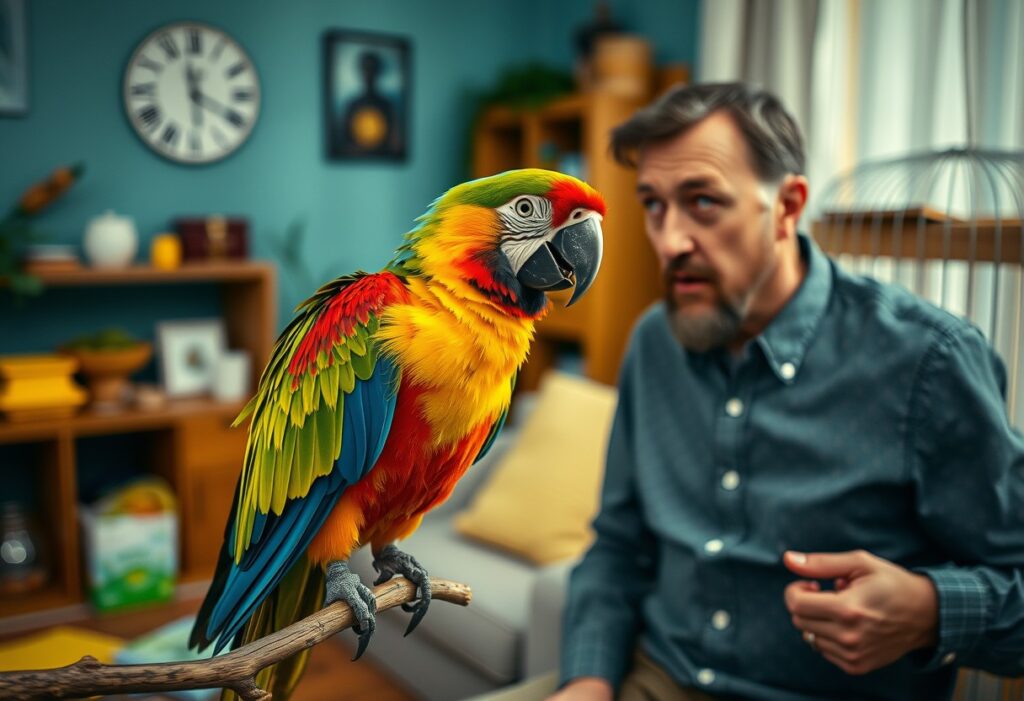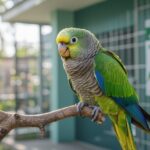Night frights can be a serious concern for pet bird owners, often resulting in unnecessary stress for both you and your feathered friend. These sudden episodes can lead to injuries or exacerbate existing fears. To ensure your pet bird remains safe and comfortable, it’s crucial to understand the causes and implement effective strategies to mitigate these incidents. In this guide, you will learn proven tips to create a calming environment, recognize signs of distress, and foster a sense of security for your beloved companion.

Understanding Night Frights in Birds
Before entering into the specifics of how to manage night frights, it is vital to understand what they are and how they affect your feathered friends.
What Are Night Frights?
Assuming you are a bird owner, you may have experienced moments when your pet suddenly becomes agitated or frantically flaps its wings at night. This phenomenon is known as a night fright. It usually occurs when the bird perceives an immediate threat or feels unsafe in its environment, causing it to panic and react instinctively. While night frights can happen in virtually any bird species, they are more common in cockatiels, budgerigars, and other small parrots.
Night frights can be distressing not only for your bird but also for you as their primary caregiver. Birds are naturally prey animals, and as such, they have heightened senses when it comes to detecting potential dangers. This makes their reactions to perceived threats quite intense, often resulting in the bird flapping its wings violently or even potentially injuring itself in the process.
Common Causes of Night Frights
On another note, understanding the common triggers or reasons for night frights can help you provide a safer and calmer environment for your bird. Factors like abrupt noises, unexpected movements in the room, or sudden changes in light can initiate an alarm response in your pet. Many birds are especially sensitive to disturbances, and even something as benign as a door slamming or sudden movements can put them on high alert.
Additionally, changes in their environment can cause confusion and anxiety. For instance, introducing a new pet, rearranging furniture, or even light from street lamps filtering through the window can all be potential causes for your bird’s heightened fear response.
What you should also consider is that different birds have different levels of sensitivity. Some may be more prone to night frights than others, depending on their *environmental experiences*. As such, identifying the specific causes that trigger your bird’s night frights can aid tremendously in alleviating the problem.
Behavioral Factors Impacting Night Frights
One of the key aspects to consider when dealing with night frights is the behavioral factors that might contribute to your bird’s reactions. Certain behaviors, like a lack of routine or improper cohabitation, can exacerbate a bird’s anxiety levels during the nighttime hours. Birds thrive on *structure* and regularity; unexpected changes can create insecurity, leading to heightened fear responses.
- Inconsistent *routine* can increase stress
- Inadequate *socialization* may lead to increased anxiety
- New *environmental factors* can trigger panic
Assume that your bird may benefit greatly from a predictable schedule, including regular feeding times and a bedtime routine that you consistently adhere to.
Another important behavioral factor involves your interaction with the bird. Frequent handling or sudden attention during their quiet hours can also lead to surprises that may not be welcome. Ensuring your bird has a designated quiet space at night can make a significant difference.
- Establishing a *designated quiet area* can reduce stress
- Providing *consistent bedtime routines* can help calm anxiety
- Adequate *social interaction* during the day can buildup comfort
Assume that by recognizing and addressing these behavioral factors, you can create an environment that significantly reduces the likelihood of night frights for your beloved pet bird.

Preventative Measures
Even though night frights can be distressing for both you and your pet bird, there are several effective preventative measures you can take to minimize their occurrence. By making simple adjustments to your bird’s environment and routine, you can help ensure that they feel secure and comfortable while sleeping, which may lead to a more peaceful night for everyone involved.
Creating a Safe and Secure Sleeping Environment
With a little effort, you can create a safe and secure sleeping environment for your pet bird. Start by choosing a location for their cage that is away from drafts, sudden noises, and bright lights that could disturb them during the night. Consider placing the cage in a quiet room, preferably away from windows and doors where outside sounds might intrude. Additionally, ensure that your bird’s cage is free from any potential hazards, such as sharp objects or loose wires, which could pose a threat when they are startled.
Another important consideration is the type of bedding or cage lining you use. Soft, comfortable materials will provide your bird with a sense of safety during sleep. Make sure to also check the bars and structure of the cage regularly for any wear and tear that could compromise the security of your bird’s sleeping quarters.
Using Coverings to Reduce Visual Stimuli
Using coverings, such as an appropriate bird cage cover, can be a great way to reduce visual stimuli and help your bird feel more secure while they sleep. By placing a soft cover over the cage, you can limit your pet bird’s view of any potential threats – including sudden movements in the room or outside – which can prevent them from becoming anxious during the night.
Additionally, the darkness provided by the cover mimics a natural sleeping environment, signaling to your bird that it is time to rest. If your bird is particularly sensitive to light, opt for a cover that blocks out as much light as possible while still allowing for proper ventilation.
Preventative measures can be highly effective in reducing the chances of your bird experiencing night frights. By ensuring that their environment is as calming and secure as possible, you can boost their confidence and sense of safety.
Establishing a Nighttime Routine
Any pet owner can benefit from establishing a consistent nighttime routine that signals to your bird that it is time to settle down. Begin this routine as early as possible, allowing your bird to anticipate the end of the day, which can help to alleviate anxiety. This could include dimming the lights and gradually quieting the environment as you approach bedtime. You may also want to spend some quality time with your bird just before bed, offering them gentle petting or soft talking to create a soothing atmosphere.
As part of this routine, it is vital to maintain a consistent feeding schedule. Feeding your bird at the same time each evening can help create predictability, which is comforting for them and signals that bedtime is approaching. Over time, your bird will begin to associate these actions with a peaceful night’s sleep.
Routine is key to mitigating night frights in pet birds. By introducing a well-structured nighttime schedule, you can foster an environment of tranquility that allows your bird to relax and unwind ahead of sleep.

How to Calm Your Bird During a Night Fright
After experiencing a night fright, your pet bird may be feeling overwhelmed and anxious. It is crucial to act swiftly and compassionately to calm them down. Understanding how to provide comfort and reassurance during this distressing time can help your bird feel safe and secure in their environment.
Providing Comfort and Reassurance
Now that you recognize the signs of a night fright, your first step is to create a soothing atmosphere for your feathered friend. Dim the lights in the room to help reduce the intensity of their surroundings. Birds can be sensitive to abrupt changes and sudden noises, so limiting stimulation will aid in their recovery. Covering their cage with a light blanket can also provide a sense of security. This mimics the feeling of being in a cozy nest, allowing your bird to feel protected from perceived threats.
You should also speak softly and gently to your bird, offering words of comfort. Let your pet know you are there for them by using a soft tone and avoiding sudden movements. Your presence can significantly alleviate their fear, helping them to understand that they are safe. Reassurance comes in many forms, but the most important aspect is being patient and consistent in your actions.
Techniques for Soothing Your Bird
Soothing your bird is crucial after a night fright. One effective method is to gently stroke or pet your bird to help lower its stress levels. If your bird enjoys physical contact, this technique can create a sense of calm and security. Additionally, playing soft music or nature sounds can distract your pet from lingering fears and help promote relaxation.
Birds are social creatures, and their need for companionship can be met during these anxious times. Talk to them or even sing softly to engage them without overwhelming their senses. Ensure your movements are controlled and slow to avoid alarming them further. Keeping your own emotions in check is crucial, as birds can pick up on your anxiety, which may inadvertently elevate their stress levels.
Birds can be resilient, but sometimes they may need a gentle push to help them settle after the fright. It’s crucial to observe their behavior closely, as each bird is unique in how they respond to disturbances. In some cases, allowing them to realize that the danger is past by not intervening can be more beneficial than an immediate response.
When to Intervene versus Letting Them Settle
On occasion, you might notice your bird becoming agitated despite your calming efforts. Knowing when to intervene versus allowing your pet to settle independently can be a fine line. If your bird continues to exhibit stress signals, such as loud vocalizations or frantic movements, you may need to step in to provide the comfort it needs. However, if your bird is simply quiet and still, it might be better to let them process their fears on their own.
For instance, if your pet has calmed down after a few minutes and is clutching its perch, it may be best to let them settle without interference. However, if they seem trapped in distress, removing them from their cage or softly cradling them can help them regain their composure. Regularly monitoring their behavior will give you insight into their comfort levels and guide your actions in future instances. With patience and understanding, you can help your bird overcome these frightening moments.
Conclusion
Summing up, dealing with night frights in your pet birds is an imperative aspect of ensuring their well-being and comfort. By maintaining a consistent and calm environment in your home, you can greatly reduce the likelihood of night frights occurring. Ensure that your bird’s sleeping area is dark, quiet, and secure, as this helps mimic their natural habitat and promotes a sense of safety. Additionally, you may consider using covers for their cages or dimming lights during sleep hours to further minimize disturbances that could trigger fear.
Moreover, paying attention to your bird’s body language and behaviors can offer important insights into their feelings and stress levels. If you notice persistent night frights, it may be worthwhile to evaluate potential causes such as environmental changes, stressors, or even health concerns. Recall, your personal involvement and attention to your bird’s needs will not only enhance their quality of life but also strengthen the bond you share. By implementing these strategies, you can help your feathered friend feel more secure, ultimately leading to a happier and healthier pet.
FAQ
Q: What are the signs that my pet bird is experiencing night frights?
A: Night frights in pet birds often manifest as sudden, panicked behavior during the night. Signs to look for include excessive flapping, vocalizations, and attempts to escape from their cage. You might also notice that your bird appears startled or wide-eyed, and you may find them on the floor of the cage or clinging to the bars, which indicates they may have fallen or are attempting to flee from perceived threats. If such behaviors occur regularly, it may be a clear indication that your bird is experiencing night frights.
Q: What steps can I take to minimize the occurrence of night frights in my pet bird?
A: To reduce the likelihood of night frights, create a calm and secure environment for your bird during the night. Start by ensuring the cage is in a quiet, low-traffic area to minimize disturbances. Covering the cage with a dark, breathable cloth can help to create a sense of security and buffer against sudden changes in light. Additionally, making sure your bird has plenty of perches and bedding can help them feel safe and secure. Regularly changing the environment to something new before bedtime can help reduce the chance of night frights as your bird becomes more accustomed to the space.
Q: Should I intervene if my bird experiences a night fright?
A: While it can be distressing to witness night frights, it’s important to approach the situation with care. If your bird is exhibiting signs of panic, it’s generally best not to intervene immediately, as this could startle them further. Instead, you can provide comfort by talking softly and reassuringly, allowing them to calm down on their own. If your bird is consistently having night frights, consider consulting a veterinarian or an avian behaviorist for additional strategies and solutions tailored to your bird’s specific needs.










